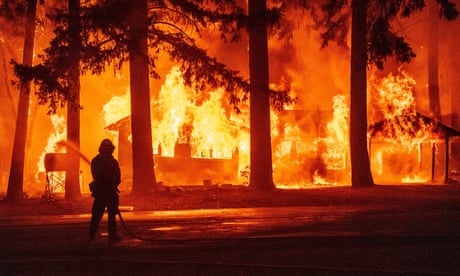INVERSE
- Tara Yarlagadda
This year will be pivotal.

|
Stocktrek/Photodisc/Getty Images
|
Forget what you thought you knew about the
climate crisis.
In terms of weather, this year will be so much more extreme than
the past — but it could also be the year we take the path to change.
Every major climate moment in 2021 reveals the potential for
innovation, resilience, and actions that both individuals and governments can
take to ride out the coming storms.
It is impossible to put a positive spin on the
extreme weather events
that marked 2021, and which will only become more frequent in the coming years
due to global warming.
But as we get a New Year underway, it is
worth examining
11 of the wildest climate takeaways of 2021 —
and the helpful steps forward they reveal that can help us address the crisis
head-on.
In brief, our shortlist comes down to these 11 lessons:
11. Trees’ growing seasons are changing
10. Far more fossil fuels need to stay underground than we
thought
9. Climate change needs a messaging reboot
8. The permafrost is more critical to the future of Earth than
you know
7. We now know when polar bears will disappear — unless we
act
6. The fate of the Arctic and the western United States are
connected
5. A maligned animal could help solve global warming
4. Cities need to change for one vital reason
3. The Amazon rainforest may not save us
2. Animals are evolving to cope
1. It’s not so simple as taking a year off from air travel
Let’s dive into each of these lessons...
● ● ● ● ● ● ● ● ● ● ● ●
● ● ●
11. Trees’ growth seasons are changing — and making allergies worse
Climate change affects trees and plant life — and, in turn,
our seasonal allergies. According to a February 2021 study, warming temperatures lengthen the spring
pollen season, in turn worsening the symptoms of seasonal allergies and other
respiratory issues.
A second study suggests warmer temperatures in
cities, in particular, are causing trees’ leaves to
turn green earlier
in spring. The autumnal leaf color change occurs later, in contrast
— again, likely exacerbating allergies.
Here’s the solution
Trees have been shown to
cool cities down, and advocates have encouraged tree planting to offset carbon dioxide
emissions contributing to global warming.
But these studies and
other research suggest we need to be more conscientious about where, when, and
how we go about planting trees in cities, taking into account how their growing
season is affected by urban environments.
The best thing you can do to minimize pollen exposure is to avoid outdoor
activities early in the morning — when pollen counts are highest — and to close
your window at night.
● ● ● ● ● ● ● ● ● ● ● ●
● ● ●
10. Fossil fuels need to stay in the ground
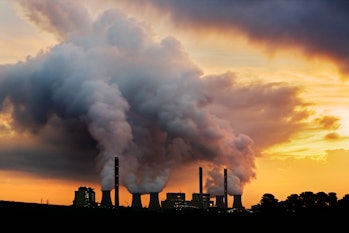
|
A coal power station. Researchers say 90 percent of the world’s
coal must remain in the ground if we are to meet necessary climate
change targets. Getty
|
A coal power station. Researchers say 90 percent of the world’s coal must remain
in the ground if we are to meet necessary climate change targets.
Getty
To keep global temperatures from rising above 1.5 degrees Celsius above
pre-industrial levels — the ideal benchmark to avert climate catastrophe — in a
paper published earlier this year, a team of researchers
says
we have to keep the majority of the world’s fossil fuels in the ground. That
includes 97 percent of the coal in the United States.
Specifically, the researchers state:
-
Sixty percent of the world’s oil and methane gas needs to remain unextracted
- Ninety percent of the world’s coal needs to remain unextracted
Here’s the solution
We need to speed up the transition to
renewable energy.
To that end, the researchers give five specific suggestions to make the
transition toward renewable energy:
- Nix production subsidies for fossil fuels
- Tax the production of fossil fuels
-
Penalize companies that fail to comply with fossil-fuel regulations,
especially methane leaks
- Ban new fossil-fuel exploration
-
Institute international initiatives, like
a treaty
on the non-proliferation of fossil fuels
● ● ● ● ● ● ● ● ● ● ● ●
● ● ●
9. People care about climate change
Earlier this year, the United Nations released findings from the
People’s Climate Vote, the world’s largest survey on climate change thus far. It encompasses 1.2
million participants from 50 countries.
You can read
our full summary
of the key findings, but the biggest takeaway of all is people of all ages
recognize climate change is an emergency. Yet not everyone favored urgent
action, suggesting a lack of education around climate change issues — there
is also a clear generational difference in how people think about climate
change. According to the findings:
"Nearly 70 [percent] of under-18s said that climate change is a global
emergency, compared to 65 [percent] of those aged 18-35, 66 [percent] aged
36-59 and 58 [percent] of those aged over 60."
Here’s the solution
The report clearly states “more education is required even for those people who
are already concerned about climate change.” Organizations like NASA are on it —
the space agency currently offers climate change curriculum
resources
for U.S. schools.
The report also highlights four popular climate-change policies for governments
to aim toward:
- Conservation of forests and land (54 percent)
- Solar, wind, and renewable power (53 percent)
- Climate-friendly farming techniques (52 percent)
- Investing more in green businesses and jobs (50 percent)
● ● ● ● ● ● ● ● ● ● ● ●
● ● ●
8. The permafrost is an overlooked and critical factor in global
warming
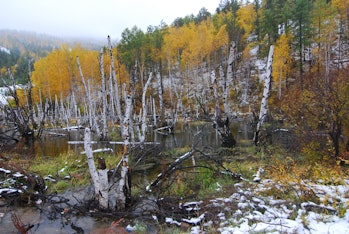
|
Thawing of the permafrost is flooding forests in Siberia — and
exacerbating global warming. Getty
|
Thawing Siberian permafrost — a layer of soil that normally remains frozen
year-round — has unearthed the terrifying remains of
ancient creatures, but an even scarier thing is emerging from beneath the ice.
In 2021, scientists
concluded
policymakers, including at the UN, aren’t focusing enough on the emissions
released from the melting permafrost and Arctic wildfires. The researchers
predict carbon dioxide emissions from permafrost may increase by 30 percent by
the end of the century — a metric that isn’t being considered in climate change
conversations.
As a result, policymakers may be seriously underestimating the amount of fossil
fuel emissions we need to reduce to keep global warming in check.
Here’s the solution
Scientists need to warn policymakers of the imminent threat posed by permafrost
thaw and Arctic wildfires, especially ahead of key climate talks.
The UN wrapped up its climate change conference,
COP26,
earlier this year, but will reconvene in Egypt next year for further discussions
— the permafrost should be on the agenda.
● ● ● ● ● ● ● ● ● ● ● ●
● ● ●
7. When polar bears will disappear
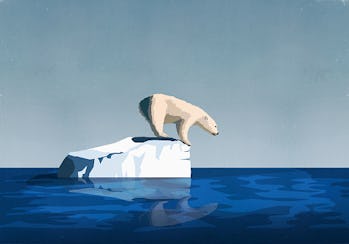
|
It’s not too late to save the Arctic or the polar bears, but we
have to act now to reduce greenhouse gas emissions. Getty
|
Scientists have been sounding the alarm on the threat melting Arctic ice poses
to polar bear habitats, but in 2021, they put an extinction date on this iconic
species — if we should fail to act on climate change.
Under a scenario of high greenhouse gas emissions, Arctic summer ice will
completely melt by 2100, killing off the ice-dependent polar bear as well.
Here’s the solution
If we can lower greenhouse gas emissions and global warming to below 2 degrees
Celsius Celsius above pre-industrial levels, summer ice — and polar bears — in
the Arctic will still have a fighting chance.
Countries can also establish protected marine reserves, like Canada’s
Tuvaijuittuq Marine Protected Area, to reduce pollutants that harm sea ice.
● ● ● ● ● ● ● ● ● ● ● ●
● ● ●
6. Ice melt fuels extreme weather
In 2021,
wildfires raged
out of control from California to Greece. Longer and drier fire seasons, fueled
by climate-change-driven drought, were to blame. But scientists also recently
identified a devastating link between wildfires and a surprising place: the
Arctic.
Using scientific models, researchers demonstrated how melting Arctic sea ice
could be linked to hotter and drier weather in the western U.S. through air
circulation patterns. So, melting Arctic sea ice could indicate a greater risk
of wildfires in this region.
Here’s the solution
Researchers are hopeful that their findings can inform better fire management in
the western U.S. since they can track the loss of Arctic sea ice a few months in
advance of fires in the U.S. and prevent wildfires from occurring in the first
place.
● ● ● ● ● ● ● ● ● ● ● ●
● ● ●
5. Cows may have a silver-lining
Scientists have
long recognized
the devastating effect of cows’ belches and farts, which release methane into
the atmosphere.
But what if we could harness cows to help save us from the climate crisis? It’s
a radical idea, but two recent pieces of research suggest it’s not a completely
farfetched idea.
Here’s the solution
The first study proposes potty training cows to urinate in specific areas,
thereby limiting the flow of nitrous oxide from their pee. Nitrous oxide is a
greenhouse gas that is 300 times more potent than carbon dioxide, so this
bizarre experiment could have seriously positive results for the climate.
The second study tackles the problem of plastic recycling using cows, or,
rather, their guts.
Single-use plastic products
clog our landfills, and their production
contributes to global warming. Researchers
found
that bacterial enzymes in the cow’s rumen are very good at decomposing plastic.
Don’t worry — this doesn’t mean we’ll feed plastic to cows. Instead, researchers
suggest acquiring cow rumen from slaughterhouses and using their bacterial
enzymes to degrade plastic on a commercial scale.
● ● ● ● ● ● ● ● ● ● ● ●
● ● ●
4. Record-breaking heat hits multiple cities
2021 may go down as the first hottest year of the rest of our lives. Heatwaves
scorched much of the western US in June 2021, followed by
record-breaking
December temperatures.
Rising temperatures are one of the most keenly felt effects of
the climate crisis
this year — and cities are especially vulnerable due to the urban heat island
effect, which traps heat in asphalt. Researchers revealed
a map
showing which cities — such as Dhaka, Shanghai, and Baton Rouge — are greatest
at risk of deadly urban heat.
Here’s the solution
There are ways we can beat the heat. In parts of India,
climate-resilient cities
are getting ahead of heatwaves by painting white “cool roofs” that deflect
sunlight.
The UN also released a list of
six cities
that are using climate-friendly cooling methods. Among them is Paris, France,
which takes water from the Seine River, chills it, and runs it through pipes
surrounding buildings for cooler temperatures — an eco-friendly A/C
replacement.
● ● ● ● ● ● ● ● ● ● ● ●
● ● ●
3. Deforestation is turning the Amazon rainforest into a carbon emitter
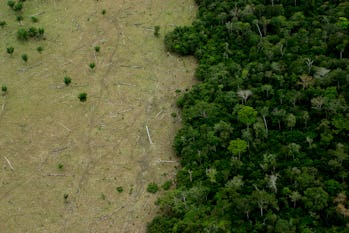
|
Large swaths of the Amazon are being deforested for cattle
grazing, contributing to global warming. Getty
|
Environmentalists often refer to the Amazon as “the world’s lungs.”
Historically, it’s been one of the world’s largest carbon sinks — places that
absorb more carbon dioxide than they emit, helping reduce the impact of global
warming.
But due to rampant deforestation in the Amazon, the rainforest has turned from
one of the world’s largest carbon sinks to one of its biggest emitters. Two
shocking findings from earlier this year confirm this trend.
First, a study published in
Nature found the rainforest is now emitting
0.3 billion tons
of carbon into the air each year. Second, a study published in
Proceedings of the National Academy of Sciences found deforestation and
climate-change-related drought is
significantly reducing the Amazon’s role
as a carbon sink.
Here’s the solution
We need to halt deforestation in the Amazon — fast.
World leaders at the UN’s
COP26 conference
announced a landmark initiative to end deforestation by 2030, which will,
presumably, focus heavily on the Amazon. Brazil, which controls much of the
Amazon, also signed this pledge.
Meanwhile, consumers can consider if products they consume are resulting in
deforestation in the Amazon. Trees in the Amazon are commonly cut down to
make room for
soy production and grazing for cattle, AKA, beef.
● ● ● ● ● ● ● ● ● ● ● ●
● ● ●
2. Animals are adapting to climate change

|
Ribbit, ribbit. Climate change is here. Getty
|
Frogs
are aging rapidly due to climate change. Animals like rabbits are
evolving longer ears
to cope with hotter temperatures.
Some birds in the Amazon are b
ecoming smaller
to cope with drier conditions. Other birds, who could theoretically help save
plants from the climate crisis by transporting their seeds to cooler northern
climates, are counterintuitively
flying south
to hotter environments instead.
In short: animals are transforming and migrating in a number
of ways due to climate change — and not all of them are good.
Here’s the solution
With more animals on the move to escape warmer environments during climate
change,
some scientists
are saying we need to reconsider how we consider so-called “invasive” species
that are not native to a region.
To be clear: Invasive species are no joke, and can significantly reshape
ecosystems around the world, even in remote places
like Antarctica.
But as climate change forces animals to move north, some ecologists are
suggesting these animals are not invasive species, but, rather, climate
refugees. Other scientists
suggest
invasive species can be reduced or managed, but don’t need to be eliminated
entirely.
● ● ● ● ● ● ● ● ● ● ● ●
● ● ●
1. Greenhouse gas emissions are up — but there is a silver lining
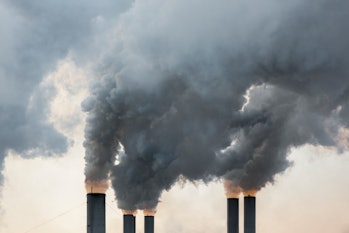
|
Fossil fuel emissions spiked once again in 2021, but emissions
may have overall flattened over the past decade. Shifts in
electric vehicles and transportation could help reduce
greenhouse gas emissions in the near future. Getty
|
Despite greenhouse gas emissions briefly plummeting in spring 2020 due to
worldwide lockdowns, by early 2021, NASA’s early 2021
climate data
shows that global warming continued unabated, making the past decade the hottest
one on record.
As lockdowns ended and global consumption returned, experts predicted that
humans will emit
36.4 gigatons
of carbon dioxide in 2021. According to the
Global Carbon Project, carbon dioxide levels rebounded by 4.9 percent in 2021, with India and China
seeing particularly large spikes in coal.
On a slightly positive note: Emissions from the oil industry are lower in 2021
than 2019, and the researchers suggest that overall carbon dioxide emissions may
have flattened over the past decade, though these results are still
preliminary.
Here’s the solution
The message from climate scientists is loud and clear: We need to shift
away from fossil fuels as quickly as possible to save our planet from
catastrophe.
On the political level, leaders recently came together at the
UN COP26 climate conference
to agree to several landmark agreements on reducing fossil fuels, from creating
a “Beyond Oil & Gas Alliance” to a global pledge to reduce methane — a
significant contributor to carbon emissions.
On a corporate and individual level, some of the most promising efforts to cut
fossil fuel emissions are coming in the field of transportation, which accounted
for
29 percent
of 2019 greenhouse gas emissions in the U.S.
Numerous
reports
suggest electric vehicles are nearing a “tipping point” to make them more
affordable for the masses. As e-bike sales grew
145 percent
during 2020 and 2021, that
e-cycling trend
will also go a long way in taking fossil fuel-guzzling cars off the road.
Links

